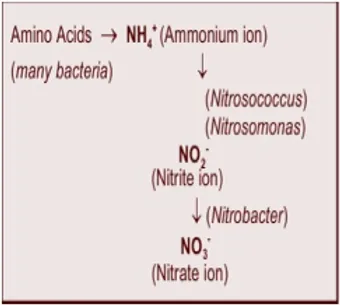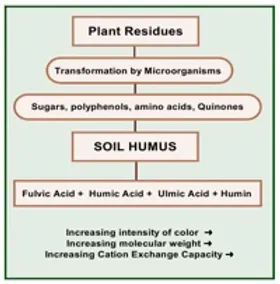Good horticultural practices for rose growing, as well as other plants and vegetables, nearly always stress the importance of adding organics. For instance, the application of an organic mulch is recommended as a top dressing to improve both water conservation in the hot summer months but also to provide the soil with an ample supply of decaying compost. As decomposition of theses organics take place, the production of humic acids is the end product. It is often referred to as “Humus”. As leaf litter (including deliberate beneficial applications of cotton seed meal and alfalfa) and other vegetable crops decay, the process first produces Duff (a partially decomposed mixture) followed by Leaf Mold (a mixture of Duff with beneficial fungal properties) and then finally Humic Acids. But Humic Acids are not that simple to define being a mixture of complex macromolecules. While Humus Acids are the end products of decomposition of soil organic matter derived either in a composting environment or occurring naturally within the soil, they represent a mixture of four main distinct components.
-
Humic Acid not soluble in water under very acidic conditions (pH<2) but soluble at higher pH levels. This portion of humus is the major extract used in horticulture. The color is dark brown to black.
-
Fulvic Acid is the portion that is soluble in water under all pH levels. The color is light yellow to yellowish-brown.
-
Ulmic Acid – also known as Hymatomelanic acid, a minor fraction that is soluble in alkaline.
-
Humin is the remaining fraction that is not soluble in water at any pH.
Humic Acids Enhances Fertilization
To rose growers the major benefits of adding Humic Acids to fertilization programs residues in the huge increase in Cation Exchange Capacity (CEC). Cation Exchange Capacity (CEC) quantifies the ability of a soil to provide a nutrient reserve for plant uptake. In scientific terms CEC is the sum of exchangeable cations (positively charged ions) soil can adsorb per unit weight or volume and is usually measured in milligram equivalents per 100 g. Translated this term means that Humic Acids provide a way of storing the various nutrients (the so called cations of Calcium, Potassium, Magnesium, Nitrate Nitrogen, etc. for absorption by the root system rather than allowing them to travel to the water table below and be lost to be plant. By far the most important ions are the primary nutrients, Nitrate (HN4 +), Phosphorus (P+), and Potassium (K+).
The ammonium ion, the principal source of nitrogen, both as an applied fertilizer as well as from decomposition of various organics (cotton seed meal and alfalfa), requires conversation by various soil bacteriums into the Nitrate ion (NO3-). The retention of Nitrate ions NH4 onto the various + Humic Acids structures via cation exchange allows the conversion to take place for later assimulation by the root structure. While various naturally occurring soils have a low CEC value (0-75), soil humus has the highest levels of all (150-250).

In lay terms, both clay and organic matter have tremendous numbers of negatively charged sites that can hold positively charged ions to their surfaces. This process of grabbing the positive ions is termed as Cation Exchange Capacity (CEC) and provides a reservoir of nutrients close to the root structure. Nutrient ions, once attracted to the various humic acids are then available for rapidly exchange with other soluble ions leading to adsorption through the roots of the plant. The process of altering the pH of an acidic soil by adding lime is illustrated in the diagram.
The preponderance of hydrogen ions (H+) attached to the clay-organic soil particle has resulted in a soil with a pH level well below that required for efficient and rapid nutrient exchange to the roots of the plants. The addition of lime (or the fine powdered dolomite lime) provides a large quantity of Calcium ions (Ca++) and Magnesium ions (Mg++) which readily exchange with the hydrogen ions and the aluminum ions to hereby raise the pH to a satisfactory level for optimum rose growing (pH 6.5 -7.0). (see diagram- yellow box below)

Conclusions
With the proliferation of applied chemical based fertilizers to provide a complete diet of primary, secondary and micro-nutrients to the rose plant, it necessary to also provide a mechanism for efficient transfer of these nutrients to the roots system. Employing an organic aspect to fertilization programs is fundamentally important to exploit fully efficient transmission. There are several ways to accomplish this task.
-
Depend solely on an organic approach knowing that bloom production will not attain that of chemical programs. This option will ensure a good soil via natural processes.
-
Devise a feeding plan that is equally composed of chemical versus organic using such organics as cotton seed meal and alfalfa or other organic base fertilizers.
-
Maintain a 100% chemical program with addition of a good organic mulch and most importantly the regular monthly application of Humic Acid via your composting. This combo of chemical and Humic Acid derived from composting will enhance your rose growing experience.
BENEFITS OF HUMIC ACIDS
Physical Property Changes
-
Very small clay particles called floccules, along with charged organic humic acids form bonds that permit greater stability and persistence within the soil matrix composed of much large aggregates leading to formation of blocks that improve the circulation of water and air around the roots.
-
As organic matter increases, so does soil water holding capacity. The water capacity of humus compared to silicate clay soils is 4 to 5 times.
-
Improves the structure of soil and increases aeration of soil leading to better workability.
-
The darker color imparted leads to greater absorption of solar energy providing warmer sub soil temperatures.
Chemical Changes
-
Serves as a buffer to neutralize both excessive soil acidity and alkalinity ensuring that nutrient ions are not rendered insoluble and unavailable to the plant.
-
Serves to strongly bind aluminum to reduce toxic effects.
-
Improves both the uptake and retention of vital nutrients.
-
Accelerates decomposition of soil minerals.
-
Induces high Cation Exchange Capacity (CEC) ensuring retention of nutrients for later assimilation by root structure.
-
Absorbed cations (the nutrients) attract water molecules for ease of transmission to plant.
Biological Changes
-
Various growth regulators, vitamins, amino acids, auxins, and gibberellins, are formed as organic matter decays just enhancing growth.
-
Stimulates root development
-
Enhances natural resistance against diseases.
-
Stimulates overall plant growth by increasing microbial like by up to 2000 times in just a few weeks.
-
Excellent food source for mycorrhizal fungus.
Tommy Cairns, ‘Soil Science Humus: The Importance of Humic Acid’, Mar/April 2014. Roses 90210, Tommy Cairns, ed. The Beverly Hills Rose Society.




























































